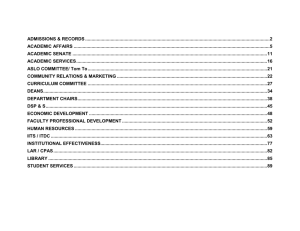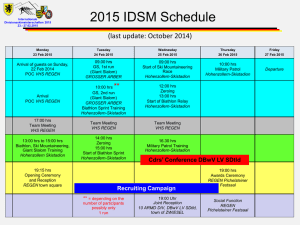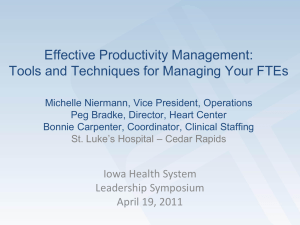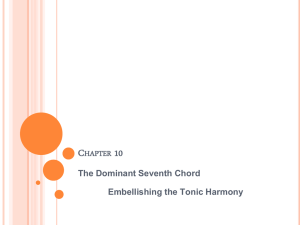Using the 16- and 8
advertisement
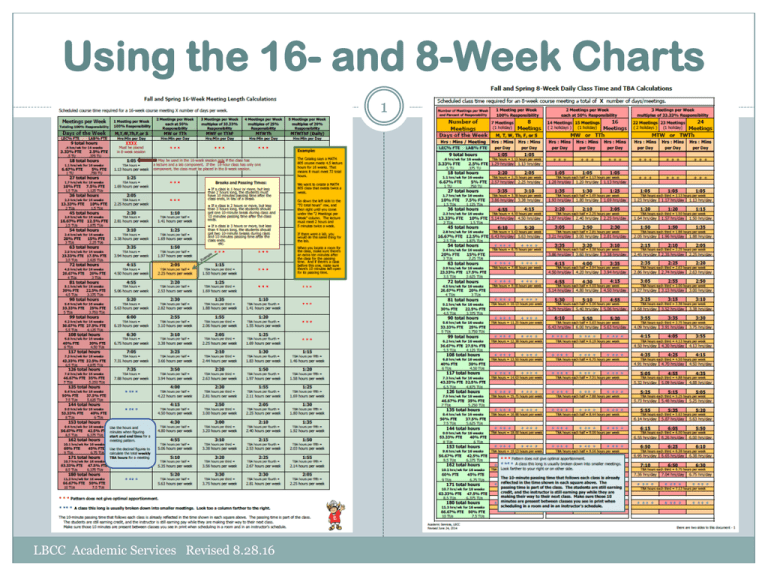
Using the 16- and 8-Week Charts 1 LBCC Academic Services Revised 8.28.16 The 16-Week Chart 2 LBCC Academic Services Revised 8.28.16 Lots of Information 3 The 16-Week Chart can help us figure out many things for a class: Start and End times TBA hours Percent of Responsibility FTE and TUs Number of breaks and passing times required LBCC Academic Services Revised 8.28.16 Let’s use the Example 4 Let’s go through the example on the Chart. The College Catalog says the contact hours for the MATH 805 course is 4.5 hours/week for 16 weeks, or a total of 72 total hours. (4.5 X 16 = 72) Let’s say we want to have our class meet twice a week. LBCC Academic Services Revised 8.28.16 Meeting Length 5 Look at the chart. Move down the left side until you get to the 72-total-hours row. Then move across until you reach the 2-meetings-per-week column. The highlighted box tells us that our class needs to meet 2 hours and 5 minutes twice a week. LBCC Academic Services Revised 8.28.16 Start and End Time 6 This cell could also be used for a hybrid class. Here’s how it could look as a hybrid class: If the class begins at 8:00AM, it would end at 10:05AM. We would say that our MATH 805 class would meet TTh 8-10:05AM. LBCC Academic Services Revised 8.28.16 T 8-10:05AM and WEB 2.25 hrs/wk Many Choices 7 Here are some examples of ways to offer a 72-hour class. 1 Meeting 2 Meetings 3 Meetings W 8AM-12:15PM TTh 8-10:05AM MWF 8-9:15AM OR OR OR WEB 4.5 hrs/wk T 8-10:05AM MW 8-9:15AM and WEB 2.25 hrs/wk and WEB 1.5 hrs/wk OR M 8-9:15AM and WEB 3.0 hrs/wk LBCC Academic Services Revised 8.28.16 4 Meetings * * * 3 red asterisks tells us that breaking 72 hours into 4 meetings would not give optimal apportionment. Speaking of Asterisks… 8 There are asterisks, blurbs, and text boxes all over this 16-Week Chart with all kinds of useful information. * * * We’ve already seen the 3 red asterisks. * ** * The 4 blue asterisks tell us that the meeting(s) would be too long and need to broken into smaller meetings… we must look to a column further to the right. However, we can use the TBA hours in the first column for a TBA class because students can spread the work over the whole week. LBCC Academic Services Revised 8.28.16 Passing Time 9 Remember this cell? 10 minutes passing time. When we include the 10 minutes passing time that follows the class, the class totals 2 hours and 15 minutes. The meeting length is given as 2 hours and 5 minutes. .25 hour is 15 minutes (.25 X 60 mins = 15 mins) 2.25 hours = 2 hours and 15 minutes Why the difference? LBCC Academic Services Revised 8.28.16 The students and the instructor are getting credit for the full 2 hours and 15 minutes. No Adjusting Necessary for Passing Time 10 The Passing Time is already reflected in the figures on the Chart. There’s no need to adjust the numbers shown on the Chart. The 10 minutes passing time follows the end time shown in the cells on the chart. We’ll look at Breaks and Passing Times later. LBCC Academic Services Revised 8.28.16 No Adjusting Needed for Passing Time 11 Really? No adjusting needed for passing time? Yes, really. No adjusting. What about a hybrid class? Does this look right? T 8-10:05AM and WEB 2.25 hrs/wk Yes, it does. Use the hours and minutes for the first pattern, and use the decimal figure for the TBA pattern. LBCC Academic Services Revised 8.28.16 The Tuesday meeting really goes to 10:15 when we include the passing time (2.25 hours). We don’t have to worry about passing time for work done at home, so we use 2.25 hrs/wk. Both modes of instruction are credited equally. Percent of Responsibility 12 1 Meeting 2 Meetings 3 Meetings W 8AM-12:15PM T 8-10:05AM MW 8-9:15AM and WEB 2.25 hrs/wk and WEB 1.5 hrs/wk Most classes have one instructor and need a total of 100% responsibility. The top row of the Chart gives us a clue as to what percents of responsibility should be used with the meetings we choose. In order for assignments to end up correct on the FSLA, they have to look correct in PeopleSoft. Paperwork and paperless work must be processed in Academic Services in order for the FSLA to show assignments correctly. LBCC Academic Services Revised 8.28.16 One Meeting Pattern – 100% Responsibility 13 One meeting pattern is easiest. 1 Meeting W 8AM-12:15PM The class meets once per week for 4 hours and 15 minutes, which is 100% of the class. They’re in the classroom 4.25 hours but getting credit for 4.5 hours because passing time follows. 1 When Academic Services enters Load Factor (100% Percent of Responsibility), the workload and FTE fields fill automatically. LBCC Academic Services Revised 8.28.16 Two Meeting Patterns – First 50% Responsibility 14 2 Meetings: T 8-10:05AM and WEB 2.25 hrs/wk Our hybrid MATH 805 class has two meetings. Pattern 1 is the Tuesday pattern. It will be meet 2 hours & 5 minutes. 1 Academic Services enters this information, including 50% of the workload, and then clicks on the plus sign to add the WEB pattern of this class….. LBCC Academic Services Revised 8.28.16 Two Meeting Patterns – Second 50% Responsibility 15 2 Meetings: T 8-10:05AM and WEB 2.25 hrs/wk Meeting 2 is the WEB portion. It will have the other 2.25 hours. 2 The other 50% Percent of Responsibility goes on this pattern for a total of 100% Percent of Responsibility on the class. LBCC Academic Services Revised 8.28.16 Three Meetings Pattern – 100% Total Responsibility 16 3 Meetings MW 8-9:15AM and WEB 1.5 hrs/wk Here we see that we can divide 72 total hours into thirds, or three meetings. But do we really have three meetings? Look at our class… Yes, technically we do. The class meets Monday, 8-9:15; Wednesday, 8-9:15; and it has a WEB portion where the students work independently. But we don’t have to have three meetings in PeopleSoft. We can combine the first two if they’re in the same room. (We always want to consolidate the meetings whenever possible. It means fewer lines for the class in the Schedule, online, and on the students’ printouts.) LBCC Academic Services Revised 8.28.16 Three Meeting Patterns – First 66.67% Responsibility 17 3 2 Meetings MW 8-9:15AM and WEB 1.5 hrs/wk The first two of the thirds can be combined to form the first meeting pattern since M & W both meet at the same time in the same room. 1 We’re using two of the three thirds on this pattern. 2/3 = the repeating decimal 66.66666… Go out to 2 decimal places and round up to 66.67. This pattern has 66.67% Percent of Responsibility. LBCC Academic Services Revised 8.28.16 Three Meeting Patterns – Remaining 33.33% Responsibility 18 3 2 Meetings MW 8-9:15AM and WEB 1.5 hrs/wk The last third is assigned as work to be done online. It will be the remaining 1.5 hours. 2 1/3 = the repeating decimal 33.33333… which rounds down to 33.33% This last meeting is 33.33% Percent of Responsibility. 66.67% + 33.33% = 100% total Responsibility for the class. LBCC Academic Services Revised 8.28.16 FTE and TUs 19 For each of the total hours cells in the column in the left column, the Chart gives us the total FTE and TUs for a course. The instructor for the MATH 805 class we created will be paid a total of 26.67% FTE, or 4 TUs, because it’s a 72-hour lecture class. The same percentages you use for the percents of responsibility for the meeting patterns can be used to calculate the FTE and TUs in those patterns. LBCC Academic Services Revised 8.28.16 The Percents of Responsibility and the FTE 20 1 Meeting 2 Meetings 3 meetings W 8AM-12:15PM T 8-10:05AM MW 8-9:15AM and WEB 2.25 hrs/wk and WEB 3.0 hrs/wk 100% Resp 26.67% FTE LBCC Academic Services Revised 8.28.16 50% Resp 13.33% FTE and 50% Resp 13.33% FTE 66.67% Resp 17.78% FTE and 33.33% Resp 8.89% FTE PeopleSoft, the Percents of Responsibility, and the FTE 21 You may have noticed that not everything in PeopleSoft adds up perfectly as it should. You’re right. This happens with the 16-week calendar and the wonderful world of rounding. When Academic Services enters information into PeopleSoft, they enter only the percent of responsibility. PeopleSoft then populates the workload hours and the FTE fields. There’s no way to manipulate the FTE to make it show exactly what we want to see. HR and payroll are both aware of the rounding issue. LBCC Academic Services Revised 8.28.16 Breaks and Passing Times 22 This yellow box shows the number of break(s) and the passing time depending on the length of a class. On the right, we’ve simplified the formula the Chancellor’s Office gave us to calculate the meeting length of any 16-week class and determine the number of breaks and passing times. LBCC Academic Services Revised 8.28.16 Following the 16-Week Formula Example 23 This is the formula that is used to calculate the time lengths on the Chart. If you’re curious, you can read through this example to see how it works. See how Step 4 divides the number into two parts? The last full and remaining partial hour is pulled out onto the left side. The other full hours are pulled out onto the right side. A 10-minute break is given for each full, 60-minute hour on the right side. LBCC Academic Services Revised 8.28.16 Following the Formula Example, Continued 24 The formula uses 50 as the multiplier for the last and partial hour to come up with the remaining length of time spent in the classroom. That’s because the other 10 minutes will be the passing time following the “end” time of the class. The class really lasts 3 hours and 20 minutes. LBCC Academic Services Revised 8.28.16 Use our MATH 805 Example 25 Let’s substitute our MATH 805 class into the second example. The last full and remaining partial hour will be 1.3 The full hours will be 1. A 10-minute break is given for this full hour. LBCC Academic Services Revised 8.28.16 Use our MATH 805 Example, Continued 26 Use the 50 multiplier for the last and partial hour to come up with the remaining length of time spent in the classroom. Add them together, and see that we’ll come up with 2 hours & 5 minutes, the figure that’s on the 16-Week Chart. There will be one break and a 10-minute passing time after 2 hours and 5 minutes. LBCC Academic Services Revised 8.28.16 When it’s not on the Chart 27 There are courses in the Catalog that do not have contact hours and total number of hours appearing on the Chart. For example, if a class needs to meet 7.5 hrs/wk or 120 total hours, we would not find what we need on the Chart. We would have to use the formula to calculate what the meeting times would be if it met, let’s say, twice a week. Follow the directions on the Formula Calculation: 120 / 16 = 7.5 then 7.5 / 2 = 3.75 rounds to 3.8 then 1.8 X 50 = 90 and 2 then 90 mins + 2 hours = 3 hours & 30 mins twice a week. LBCC Academic Services Revised 8.28.16 Covered 28 We have looked at each of the following items on the 16-Week Chart: Start and End times TBA hours Percent of Responsibility FTEs and TUs Number of breaks and passing times required Now we’ll move on to the 8-Week Chart. LBCC Academic Services Revised 8.28.16 The 8-Week Chart 29 The 8-Week Chart is a two-sided document. LBCC Academic Services Revised 8.28.16 The 8-Week Daily Chart 30 The reason why the 8-Week Chart needs to be two pages and have so many columns is because the meeting length is calculated by the number of meeting days. LBCC Academic Services Revised 8.28.16 The 8-Week Daily Meetings Chart 31 Classes that are fewer than 16 weeks long must have their meeting length calculated by the total number of meeting days, rather than by the meetings per week. A class that meets two days a week for 8 weeks but meets only 14 or 15 days because of holiday(s) must make up that lost time on the other days. Therefore, the meeting length might be longer for a MW class than a TTh class. Holidays don’t have to be considered in the 16-week classes, but they do in anything fewer than 16 weeks. Holidays are not counted as meeting days, but Flex days are. LBCC Academic Services Revised 8.28.16 Formula for Classes Fewer than 16 Weeks 32 The formula for the calculation of the meeting length for a class fewer than 16 weeks differs slightly from the formula for a class fewer than 16 weeks. Instead of dividing the total hours by 16 and then by the number of meetings per week, we simply divide the total hours by the total number of meeting days. LBCC Academic Services Revised 8.28.16 Following Example of Daily Calculation Formula 33 If this were a MATH 110 class, we would take 90 total hours and divide it by the total number of days… if our class were to meet MWF for 8 weeks, but there was one holiday, we would divide 90 by 23. The rest would be done the same way as the 16-week formula. We would break 3.9 into two parts as we do with the other formula. LBCC Academic Services Revised 8.28.16 Following Example of Daily Calculation Formula - Continued 34 And we’d come up with 3 hours & 35 minutes. Does it match what is on the 8-Week Chart? It surely does. LBCC Academic Services Revised 8.28.16 Use the Example on the 8-Week Chart 35 If we put our MATH 805 class into the 8-week session, we have to count the meeting days first. If it meets MTWTh and misses two meetings because of holidays, the class will meet 30 times. LBCC Academic Services Revised 8.28.16 Meeting Length – Start and End Time 36 Move down the left column until you reach 72 total hours, and then move right until you’re under the 30-meetings column. The class will meet 2 hours and 10 mins per day. LBCC Academic Services Revised 8.28.16 Start and End Time - Continued 37 So depending on what days a 4-meeting-per-week class meets and which holidays affect it, one 8-week, one 72-hour class may meet longer than another. A MTWTh class might meet 30 days, but a TWThF class might meet 29 days. LBCC Academic Services Revised 8.28.16 One Meeting Pattern – 100% Responsibility 38 Let’s look at our 8-week MATH 805 class – MTWTh 8-10:10. Academic Services enters it the same way; however, there is no place in PeopleSoft to enter anything about holidays. Academic Services enters the Percent of Responsibility the same way. But since we’ve told PeopleSoft that it’s an 8-week session, it’s altered the workload hours for us. It now says the instructor is to be paid 9 hours per week rather than 4.5. HR will work Equal Pay with the 8-week session dates and higher workload hours; the FTE and TUs do not change. 1 LBCC Academic Services Revised 8.28.16 Make that Two Meeting Patterns – 100% Responsibility 39 What if we wanted to make it a hybrid class that meets only Tuesdays & Thursdays and has the other half be WEB? Q. How many meetings per week is this? Q. Is this like the M, W, Web class we looked at on slide number 16? A. No, this is not a 16-week class. We have to count the meeting days here, remember? (We’ll have 15 total Tuesdays & Thursdays.) We counted the Tuesdays and Thursdays. But the WEB pattern is not counted by meetings; it will use a flat number of hours per week for 8 weeks. We are going to have to think outside the box. It would help if we thought of each pattern as a separate 36-hour class. What we really need for our two meeting patterns are the following: 1. 36 total hours divided into 15 meetings to cover the TTh meetings. 2. 36 total hours divided into 8 for the WEB meeting pattern. (It doesn’t matter when the holidays are for TBA hours.) 36 and 36 gives us the 72 total hours for the class. LBCC Academic Services Revised 8.28.16 Two Meeting Patterns = 100% Responsibility 40 Here we have it. Our class will look like this: LBCC Academic Services Revised 8.28.16 TTh 8-10:10AM WEB 4.5 hrs/wk Two Meeting Patterns – 50% Responsibility Each 41 1 The instructor will be paid 50% for the 15 Tuesdays and Thursdays and 50% for 8 weeks of WEB material. It’ll should all work out evenly in Equal Pay. 2 LBCC Academic Services Revised 8.28.16 Any Questions? 42 Start and End times TBA/WEB hours Percent of Responsibility FTE and TUs Number of breaks and passing times required LBCC Academic Services Revised 8.28.16 Feel free to call our office with your questions at any time. Academic Services Website 43 The 16-Week and 8-Week Charts and many other helpful documents can be found on our Website. LBCC Home Faculty and Staff Academic Services Scheduling LBCC Academic Services Revised 8.28.16
